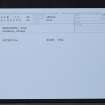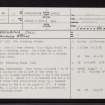Pricing Change
New pricing for orders of material from this site will come into place shortly. Charges for supply of digital images, digitisation on demand, prints and licensing will be altered.
Upcoming Maintenance
Please be advised that this website will undergo scheduled maintenance on the following dates:
Thursday, 9 January: 11:00 AM - 3:00 PM
Thursday, 23 January: 11:00 AM - 3:00 PM
Thursday, 30 January: 11:00 AM - 3:00 PM
During these times, some functionality such as image purchasing may be temporarily unavailable. We apologise for any inconvenience this may cause.
Coll, Breachacha
Standing Stone (Prehistoric)(Possible), Standing Stone (Prehistoric)
Site Name Coll, Breachacha
Classification Standing Stone (Prehistoric)(Possible), Standing Stone (Prehistoric)
Canmore ID 21582
Site Number NM15SE 15
NGR NM 1519 5329
Datum OSGB36 - NGR
Permalink http://canmore.org.uk/site/21582
- Council Argyll And Bute
- Parish Coll
- Former Region Strathclyde
- Former District Argyll And Bute
- Former County Argyll
NM15SE 15 1519 5329.
(Approx NM 151 532) Two standing stones.
Information contained in letter from D Maclean, 29 August 1972.
NM 1519 5329. One of these stones, 1.5m high, could be classified as a standing stone. The other has an old metal fence post embedded in it and is more of a boulder than a standing stone.
OS revision 16 July 1974.
(NM 1519 5329) Standing Stone (NR)
OS 1:10,000 map, (1976)
Standing Stone, Breachacha: This stone, situated 1km SW of Breachacha Castle at the E side of the track to Crossapol Bay, is aligned approximately N and S and stands to a height of 1.5m. About 1.1m in breadth and 0.6m in thickness, it rises with straightish sides to a rounded top and now leans to the W at an angle of 12 degrees. A large recumbent slab, a little to the W, is not considered to have been a standing stone.
RCAHMS 1980, visited 1974.










